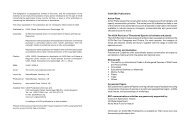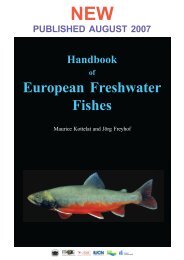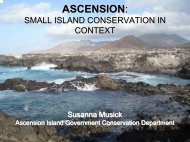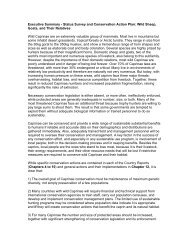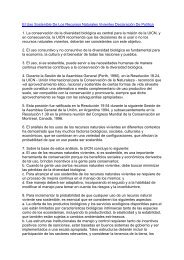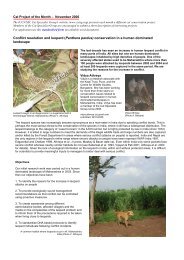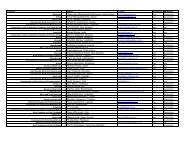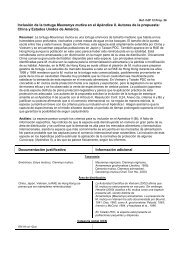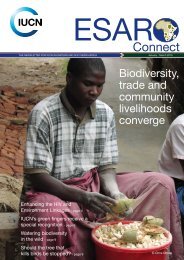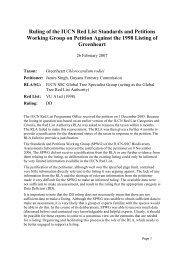Planning education to care for the earth - IUCN Knowledge Network
Planning education to care for the earth - IUCN Knowledge Network
Planning education to care for the earth - IUCN Knowledge Network
Create successful ePaper yourself
Turn your PDF publications into a flip-book with our unique Google optimized e-Paper software.
ForewordMy introduction <strong>to</strong> <strong>IUCN</strong> - The World Conservation Union, was at <strong>the</strong>General Assembly held in Buenos Aires, Argentina, in January 1994. I hadjust been designated Direc<strong>to</strong>r General of <strong>the</strong> Union. I found it enormouslystimulating <strong>to</strong> join delegates from all parts of <strong>the</strong> world - from governmentsand non-government organisations alike - as <strong>the</strong>y debated, discussed andplanned ways <strong>to</strong> <strong>care</strong> <strong>for</strong> <strong>the</strong> <strong>earth</strong> and its peoples. Their energy, sense ofcommitment, and enthusiasm impressed me and fired up my own enthusiasm<strong>for</strong> <strong>the</strong> job be<strong>for</strong>e me.Three months later, in assuming office as Direc<strong>to</strong>r-General, I <strong>to</strong>ok up <strong>the</strong>challenge of working <strong>to</strong> <strong>for</strong>ge that energy and commitment in<strong>to</strong> a morepowerful <strong>for</strong>ce <strong>for</strong> conservation. This meant fur<strong>the</strong>r stimulating <strong>the</strong> alliancebetween <strong>IUCN</strong> members, <strong>the</strong> voluntary expert networks we callCommissions, and <strong>the</strong> secretariat. It seems very apparent that only when<strong>the</strong>se three “pillars” are interlocking, that we have <strong>the</strong> underpinning <strong>the</strong>Union needs <strong>to</strong> take on <strong>the</strong> daunting environmental tasks we have be<strong>for</strong>e us.I feel strongly that if we are <strong>to</strong> stand a chance of addressing <strong>the</strong> world’scomplex environmental problems, we have <strong>to</strong> motivate public participationin caring <strong>for</strong> <strong>the</strong> <strong>earth</strong>, while meeting <strong>the</strong> development needs of people. It isnow universally recognised that <strong>education</strong> and communication are essential<strong>to</strong>ols in making this ideal of “conservation and sustainable development” areality and a part of popular thinking, acting and doing. That, at least, is <strong>the</strong><strong>the</strong>ory. As always, <strong>the</strong> practice is not so obvious.The interface between <strong>the</strong>ory and practice is exactly what <strong>IUCN</strong> was lookingat in Buenos Aires, where workshops provided an opportunity <strong>to</strong> share andanalyse international experiences based on <strong>the</strong> principles embodied inCaring <strong>for</strong> <strong>the</strong> Earth, A Strategy <strong>for</strong> Sustainable Living. To explore one of<strong>the</strong>se principles, that we need <strong>to</strong> change personal attitudes and practices inorder <strong>to</strong> <strong>care</strong> <strong>for</strong> <strong>the</strong> <strong>earth</strong>, <strong>IUCN</strong>’s Commission on Education andCommunication organized a workshop entitled “Changing attitudes andpractices”. This book is a direct result of <strong>the</strong> papers presented at thatworkshop.The book has three sections: <strong>the</strong> first seeks <strong>to</strong> provide some bases <strong>for</strong>planning <strong>education</strong> and communication, <strong>the</strong> second looks at NGO <strong>education</strong>programmes, and <strong>the</strong> third at planning <strong>education</strong> at <strong>the</strong> national level.Thus, <strong>the</strong>se sections play <strong>to</strong> one of <strong>IUCN</strong>’s unique strengths: its ability <strong>to</strong>bring <strong>to</strong>ge<strong>the</strong>r government and NGO organisations behind <strong>the</strong> banner ofconservation. No o<strong>the</strong>r organisation has NGOs, national governments, andgovernmental organisations as its members. But in order <strong>to</strong> get <strong>the</strong>governments and NGOs <strong>to</strong> really work <strong>to</strong>ge<strong>the</strong>r, we must recognize that eachhas different needs and different capacities. While NGOs may be critical ofgovernment action at times - and often rightly so - , <strong>the</strong>y also have much <strong>to</strong>offer governments in a positive sense. NGOs are good facilita<strong>to</strong>rs infostering community participation in environmental work, a role someviii



